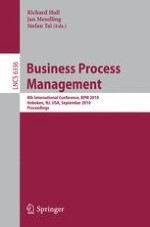The BPM Conference series has established itself as the premier forum for - searchersintheareaofbusinessprocessmanagementandprocess-awareinfor- tion systems. It has a record of attracting contributions of innovative research of the highest quality related to all aspects of business process management, including theory, frameworks, methods, techniques, architectures, systems, and empirical ?ndings. BPM 2010 was the 8th conference of the series. It took place September 14- 16, 2010 on the campus of Stevens Institute of Technology in Hoboken, New Jersey, USA—with a great view of Manhattan, New York. This volume c- tains 21 contributed research papers that were selected from 151 submissions. The thorough reviewing process (each paper was reviewed by three to ?ve P- gram Committee members followed in most cases by in-depth discussions) was extremely competitive with an acceptance rate of 14%. In addition to the c- tributed papers, these proceedings contain three short papers about the invited keynote talks. In conjunction with the main conference, nine international workshops took place the day before the conference. These workshops fostered the exchange of fresh ideas and experiences between active BPM researchers, and stimulated discussions on new and emerging issues in line with the conference topics. The proceedings with the papers of all workshops will be published in a separate volume of Springer’s Lecture Notes in Business Information Processing series. Beyond that, the conference also included a doctoral consortium, an industry program, ?reside chats, tutorials, panels, and demonstrations.
